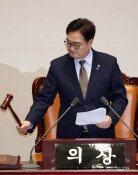No. of Foreign Residents in Korea Tops 1 Mln
No. of Foreign Residents in Korea Tops 1 Mln
Posted August. 06, 2009 08:24,
The number of foreign residents in Korea has topped a million, the Public Administration and Safety Ministry said yesterday.
Experts say the country has entered a multicultural era as expats account for more than two percent of the population.
The ministry said the number of foreign residents reached 1,106,884 May 1, exceeding the million mark for the first time since the survey began in 2006. The figure represents 2.2 percent of the population of 49,593,665 and is up 24.2 percent from last years number of 891,341.
The survey classified as a foreign resident those who have stayed in Korea for more than 90 days legal or illegal, naturalized citizens, and their children.
For the first time, the ministry examined the children of expats by age group by using the information system for family registration in this years survey. It discovered that 107,689 children of expats reside in Korea, and among them, those under age six accounted for 59 percent, or 64,040.
Seol Dong-hoon, a sociology professor at Chonbuk National University, said, The number of foreign residents topping the million mark and that of their children exceeding 100,000 illustrate statistically that Korea is showing signs of becoming a multi-ethnic society, adding, Many Koreans now consider living with foreigners as a positive phenomenon.
The biggest ethnic group living in the country was Chinese with 56.5 percent, followed by Southeast Asians including Vietnamese and Filipinos with 21.2 percent; Americans 5.4 percent; South Asians 3.9 percent; Japanese 2.4 percent.
The number of Americans jumped 119 percent from a year ago, posting the biggest gain among nationalities.
By region, Seoul had the most foreign residents with 30.3 percent, followed by Gyeonggi Province with 29.3 percent and Incheon 5.6 percent. The Seoul metropolitan region had 65.1 percent of expats.
Next was South Gyeongsang Province with 5.8 percent, South Chungcheong Province 4.1 percent, and North Gyeongsang Province 3.7 percent.
Immigrants who moved to Korea after marrying Koreans numbered 125,673. By nationality, most were Chinese with 54.8 percent, followed by Southeast Asians with 32.1 percent, Japanese four percent, and Mongolians 1.8 percent.
Most immigrants married to Koreans were women, while foreign men married to Korean women accounted for 12.1 percent.
The ministry said 16.4 percent or 181,414 of foreign residents acquired Korean citizenship, mostly through marriage. The remaining 83.6 percent or 925,470 retained the passports of their respective countries.
Professor Seol said, Korean perceptions of foreign residents have improved, but it could be time for us to think about whether prejudice against foreigners and discrimination pose an obstacle to foreigners settling in Korea.
argus@donga.com







